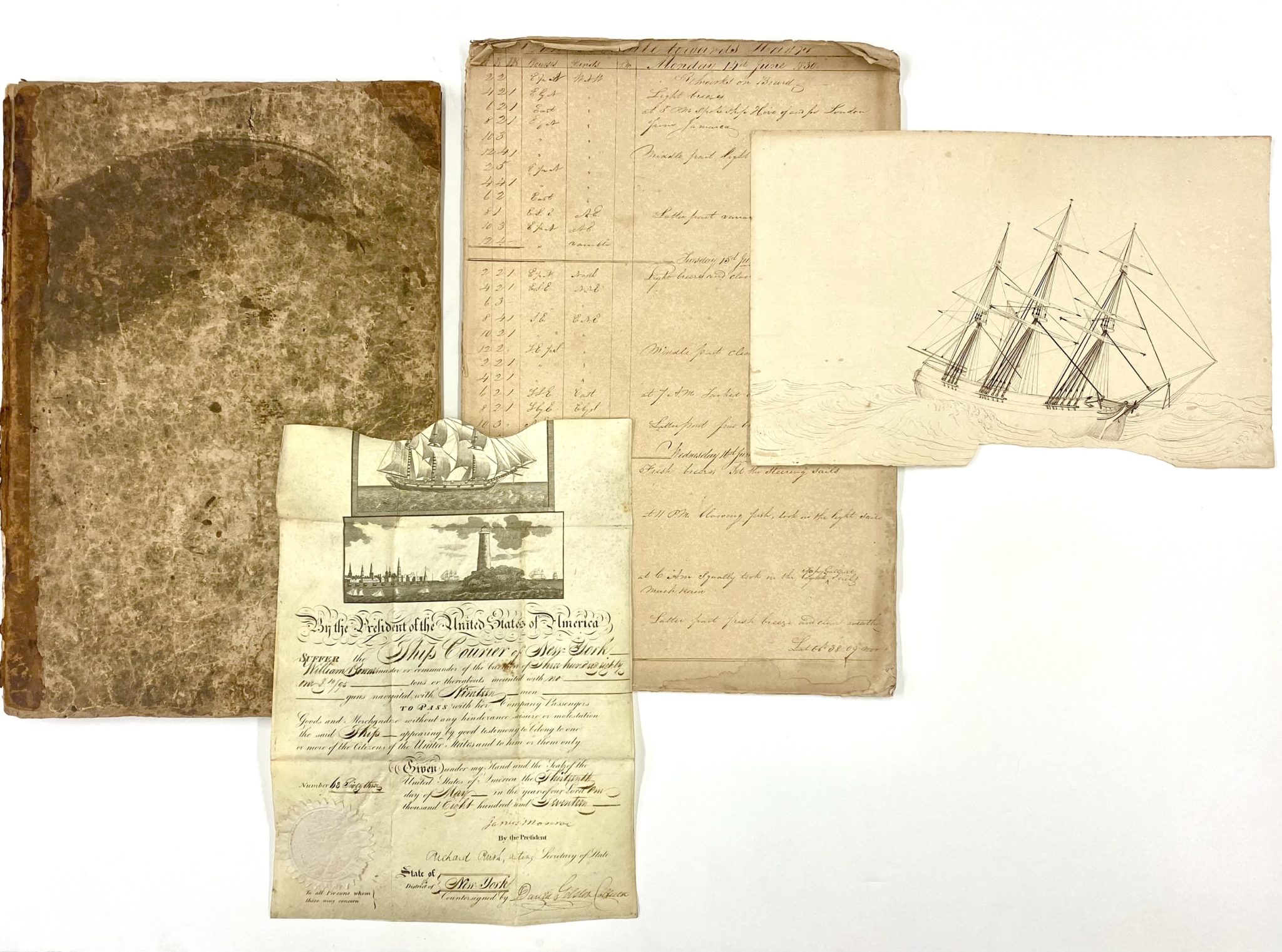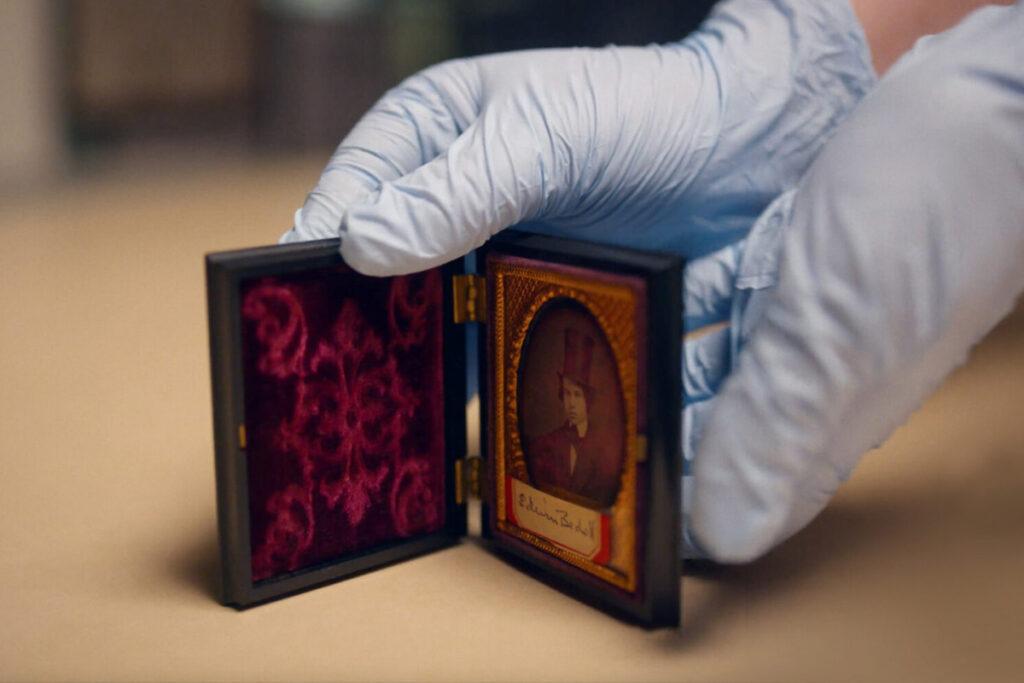The Unexpected Surprises of Art Donations
A Collections Chronicles Blog
by Martina Caruso, Director of Collections
February 24, 2022
Art or archival donations are often thrilling. But after the initial excitement, many of us who work in museums’ collection management and registration usually have a moment of apprehension. Questions arise like, did you calculate the additional hours of intake for registration and cataloging work this new donation will add on your already overworked staff? How about the cost of packing and safely shipping the piece(s)? Or, what about the extra storage this new incoming object(s) will take?
There is a lot to consider when accepting a gift. These questions are discussed during acquisition meetings and collections committee meetings, but there are often unexpected details that arise after the acquisition is formally approved. Additionally from the initial contacts with donors to the actual taking possession of the promised gifts could take months, if not years, so aspects could become slightly confused on either end of the donation. We lay down many of our acquisition criteria on our website, and explain them to prospective donors via phone and email, but they are never enough.
Sometimes though, such challenges are not actually issues, but wonderful opportunities and discoveries. This is the case for one of our recent acquisitions, approved by our Collections Committee in the midst of the pandemic.
The Donation
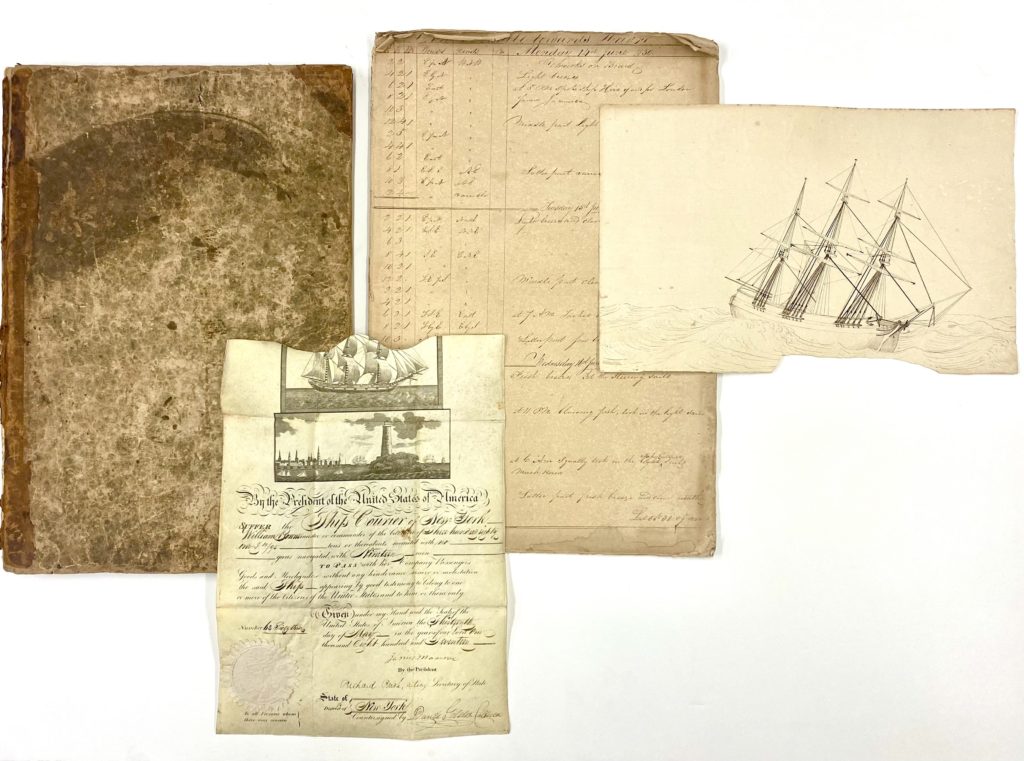
In February of 2020 we were approached by a donor who was inquiring as to whether or not we might be interested in having an antique ship’s log.
The log is from the early 1830s and documents the sailing of the ship Albany between New York and Havre de Grace, Maryland.
The donor also mentioned that within the log there were two loose sheets of paper; one document signed by President James Monroe in 1817, and an ink drawing of a ship.
This donor was stellar; she explained the materials’ provenance, and detailed as best as she could their condition. These are the types of donations you dream of. It seems an easy offer to approve, and after some research and meetings, the log with additional loose paper was coming our way with all the related documentation in place.
The Discoveries
We took possession of the log and papers in October 2021, one year and a half after the first email of offer we received, and when I opened the box, and started documenting the items in their arrival condition, I was awed by them.
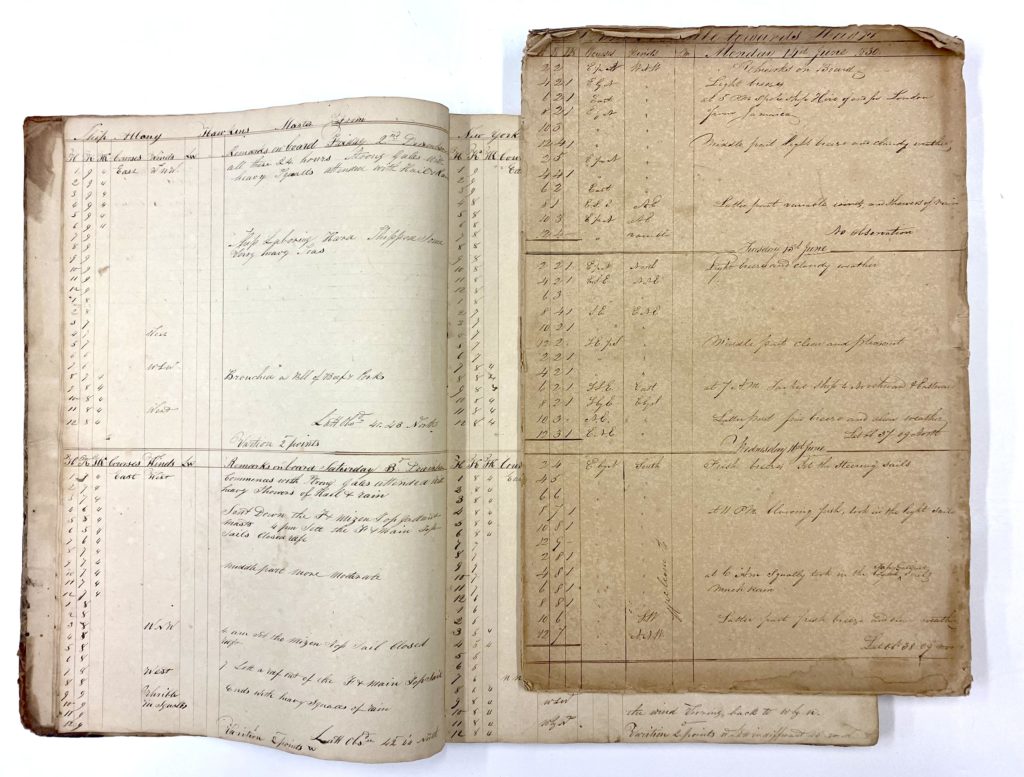
The first thing I noticed was that the ships’ log was actually two logs. One follows the donor’s description as it is from the early 1830s, and documents the sailing ship Albany. It has a paper marbling cardboard cover, and it’s roughly bounded.
The second log appears to be a partial log, composed of a set of pages bounded together, taller in heights from the first bounded log, and different in the type of paper used and handwriting style. This second log documents the voyages of the sailing ship Mersey, captained by “Master Wm Bowne”.
[Ships’ logs for the sailing ships Albany and Mersey] ca. 1830-1839. Paper, ink. Gift of Jane R. Wolff, South Street Seaport Museum 2020.002.0001.A-.B
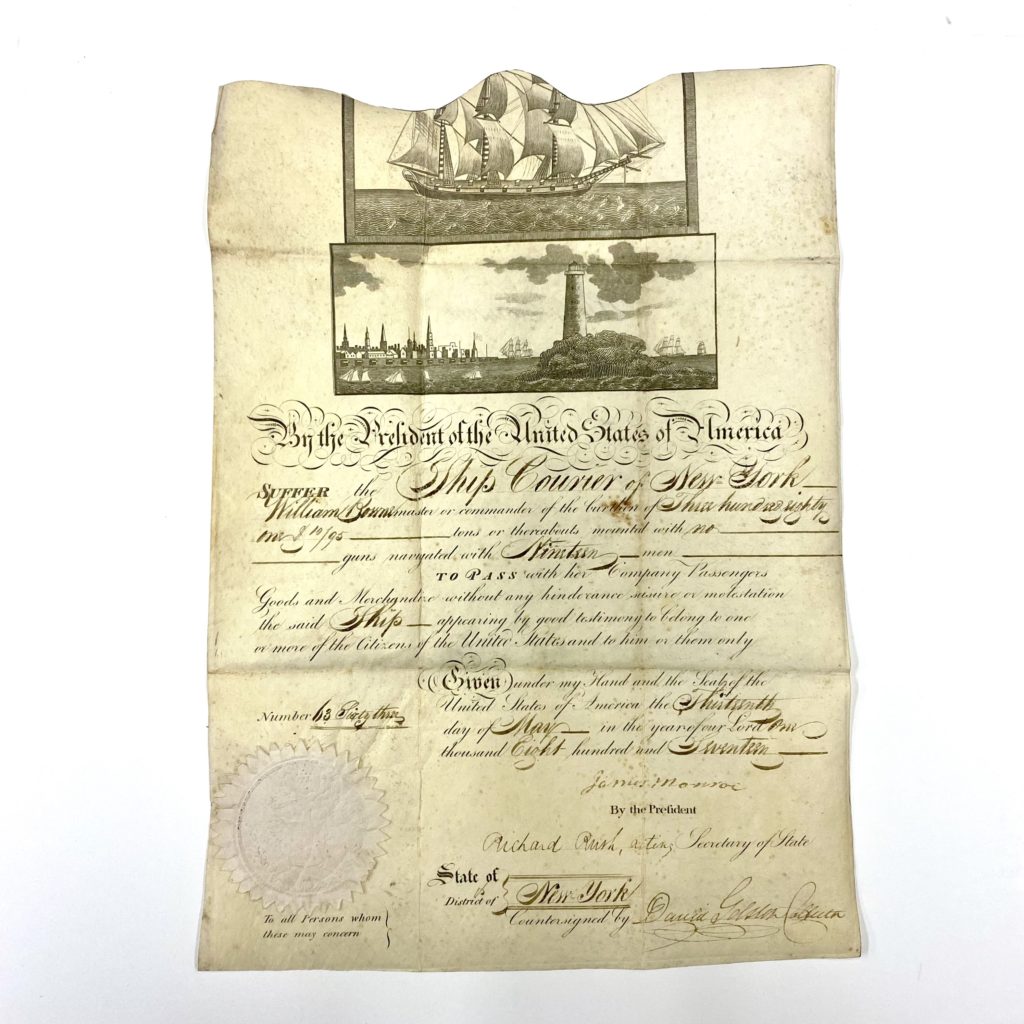
Then, when I turned my attention to the loose document in between the log pages, I quickly realized this was a very rare shipping document.
It is an official document signed and sealed by President of the United States of America James Monroe on May 13, 1817, declaring that the packet ship Courier of New York, commanded again (!) by ‘Master or Commander William Bowne” with nineteen men and no guns on board, should be allowed to travel without molestation as the goods on board belong to one or more men citizens of the United States.
[Shipping document for the packet ship Courier of New York, signed by President James Monroe] may 13, 1817. Paper, ink. Gift of Jane R. Wolff, South Street Seaport Museum 2020.002.0002
Log and document appeared immediately as two incredible documents for us. The mention of a member of the Bowne family, which could be related to “our” Robert Bowne (1744-1818), founder of Bowne & Co., was electrifying. Following, the ship name on the document, the Courier, and its date, reminded me of something; and after a few quick moments of research I confirmed the ship was indeed what I thought: one of the first four American packet ships of the Old Line, later renamed Black Ball Line, which revolutionized the maritime and shipping industry, right from Peck Slip, two blocks from the Museum and the heart of the South Street Seaport Historic District.
How many other fascinating and important aspects could these logs have been included? What kind of cargo were they carrying? How about weather and meteorological records of the coastal voyages? Let’s analyze a few of them.
Master and Commander William Bowne
Capt. Bowne is listed in our historic records as Master of the ship Courier of New York in May of 1817, and Commander of the “fine new fast-sailing American Ship Mersey” traveling from New York to London in the early 1830s.
According to one of the few genealogy and historical publications on the history of the Bowne family, the book “Bowne Family of Flushing, Long Island” compiled by Edith King Wilson in 1948, Capt. William Bowne was born in New York City on March 7, 1784, and died in Westchester county, New York, in 1847. His wife was Ann Farris and they had six children.
The book highlights the history of the family, starting from the patriarch John Bowne (1627-1695), and since the Bowne family members are important for New York, like the Schermerhorns and the Astors, I dug in a bit more.
John Bowne (1627-1695)
John Bowne, the patriarch, emigrated from England in 1649, with his father Thomas and sister Dorothy. After a short time in the Boston area, the family relocated to Flushing, then Vlissingen or Vlishing, a settlement populated by many English residents, part of New Netherland. His wife was Hannah Feake, a niece of Governor John Winthrop of Massachusetts and cousin of Governor Robert Winthrop of Connecticut, and they had eight children.
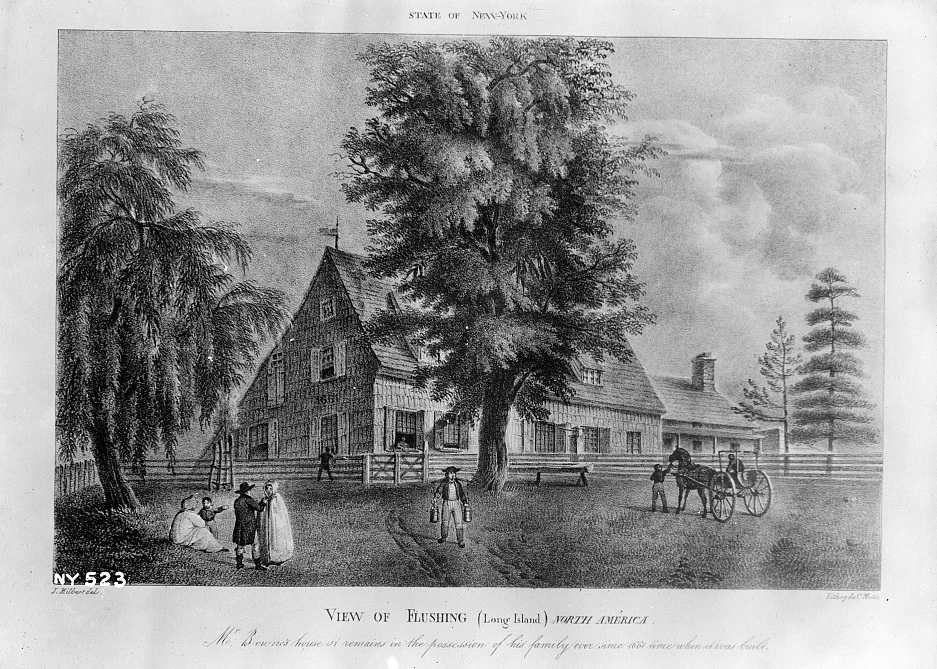
By 1662 their home had become a central meeting place for the area’s Quaker population, and they would become the region’s (Queens) most prosperous and politically important families.
John Bowne’s home still stands today, and it is considered one of New York’s symbol of religious freedom, although it was recently reported that John Bowne owned at least two slaves and an indentured servant.
“That was not unusual for a man of his time, class and place. But recent excavations at the house, combined with new historical scholarship, are making more clear how much the Bowne family and other businessmen in the region exploited slave labor for their profits.”[1] “NEIGHBORHOOD REPORT: FLUSHING; For a Beacon of Freedom, A Troubling New Light” by Jim O’Grady, published in The New York Times on February 24, 2004.
“Bowne House, 37-01 Bowne Street, Flushing, Queens County, NY” Courtesy of the Library of Congress Prints and Photographs Division.
According to the book “Bowne Family of Flushing, Long Island”, Capt. William Bowne (1784-1847) is the 3rd great-grandson (great-great-great grandson) of John Bowne.
Robert Bowne (1744-1818)
Robert Bowne was a merchant and Quaker who founded Bowne & Co. in 1775, and participated in many other notable achievements of his day including the founding of the Bank of New York, the Bank of America, and the planning of the Erie Canal. He would become known as an early American abolitionist who helped to form the Manumission Society of New York and later the African Free School.
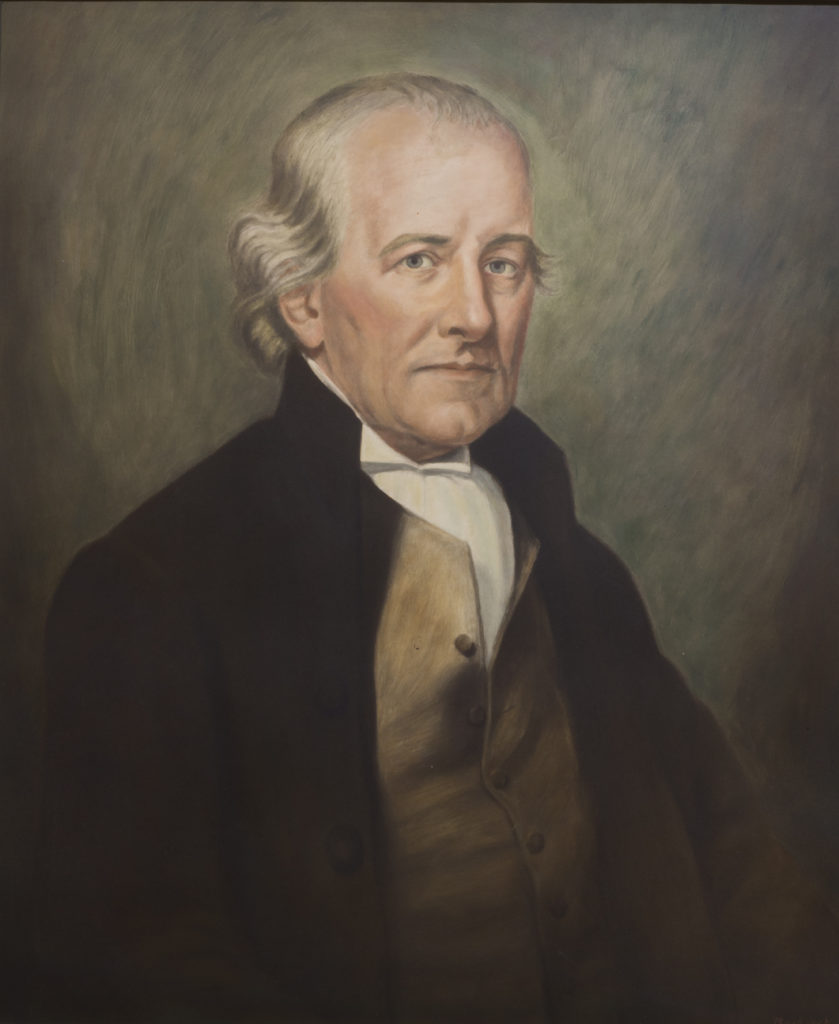
Robert Bowne is for us at the Seaport Museum an iconic founding father of our campus. He first set up his firm at 39 Queen Lane (later renamed Pearl Street), and initially, like many other New York City merchants at the time, Bowne did not specialize in one particular avenue of trade, but rather dealt in a variety of dry goods including cloth, paper, and cutlery.
Bowne & Co. gradually turned exclusively to financial printing in order to meet the growing demands of banks, insurance companies, and other businesses for commercial paper; and throughout most of the 19th century the firm had been headed by a member of the Bowne family.
Today, Bowne & Co. is New York’s oldest operating business under the same name thanks to a partnership between Bowne & Co. Inc. and the Seaport Museum which allowed in 1975 the opening of a 19th-century-style print shop, including a letterpress printing collection, and a turn-of-the-century store that is unique, eclectic and like none other in the city.
[Portrait of Robert Bowne] ca. 1975. Reproduction made by Bowne & Co. inc.
Based on the genealogy research published in Wilson’s book, Capt. William Bowne (1784-1847) seems to be Robert Bowne, 1st cousin twice removed.
Walter Bowne (1770-1846)
Walter Bowne was the mayor of New York City from 1829 to 1833, and during his tenure was a supporter of the Erie Canal project.
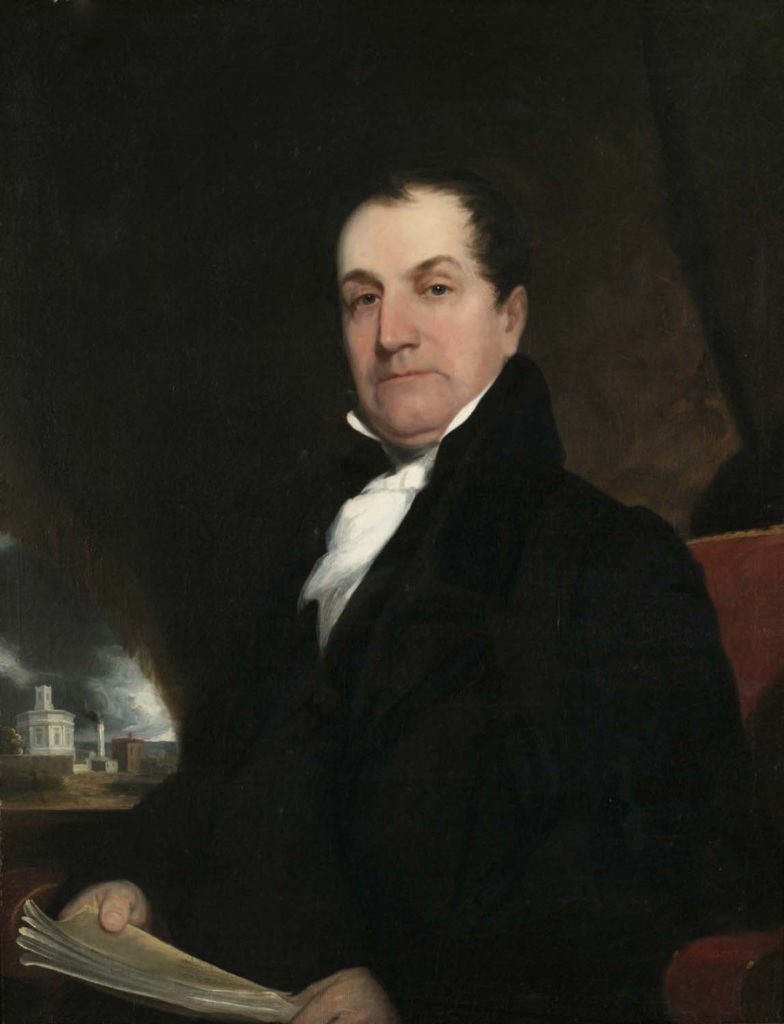
Infrastructure and water needs were in his mind; he foresaw the need for the city to establish a reservoir system in order to secure adequate supplies of water necessary for future growth, but he was unable to get anything of immediate significance done by the time he left office in early 1833.
Under Bowne, work began on constructing an overall improvement of the waterfront for industrial use, with sturdier piers of stone and new warehouses, which would eventually benefit the growing steamship traffic and trades.
In 1832 a major cholera epidemic arrived in New York City, and Walter Bowne “decided to enact a quarantine for all ships and carriages attempting to enter the city. This included all of the products and people on board.”
Robert W. Weir (1803-1899) artist. “Walter Bowne” 1833. Courtesy of New York City Hall Portrait Collection.
Capt. William Bowne (1784-1847) is Walter Bowne’s (1770-1846) 1st cousin once removed.
Robert Bowne Minturn (1805-1866)
Robert Bowne Minturn was a prominent merchant, philanthropist and patriot of the Civil War period. He was also a founder of the shipping line Grinnell, Minturn & Co., one of the leading transatlantic shipping companies in the middle 19th century, notable for its ownership of the famous clipper ship Flying Cloud. The ship which captured the record as the fastest ship sailing the 16,000 mile route from New York to San Francisco in 1851, a record that remained unbroken for twenty-three years. The company stayed “in the family” and remained active until 1880.
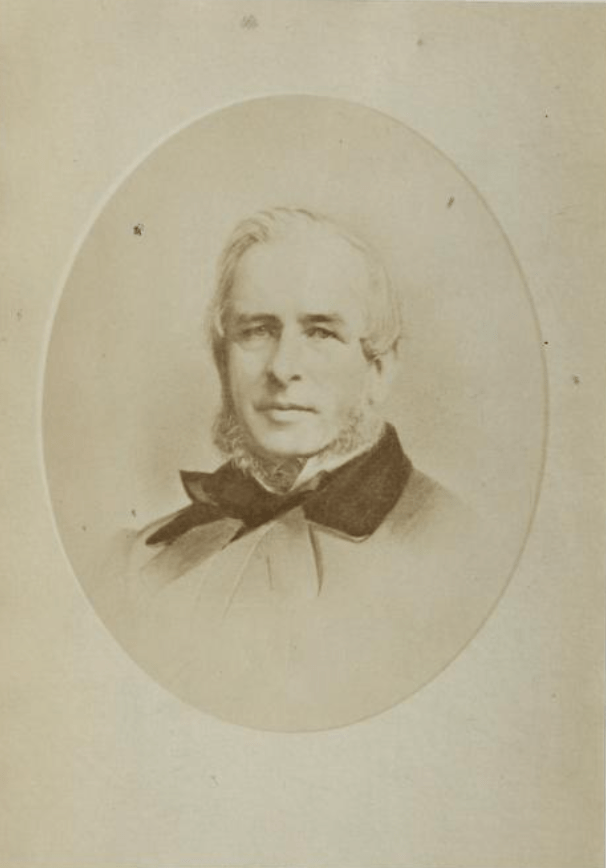
Robert Bowne Minturn and his wife Anna Mary Wendell donated land for the establishment of Central Park, and, like his Quaker ancestors, he was opposed to slavery. In fact, he helped organize and was the first president of the Union League Club, formed when the Union Club membership was divided over support for President Lincoln and the Civil War.
In 1847 was appointed as the first City’s Commissioner of Emigration to secure the rights of emigrants, and he was an active manager of charitable associations in New York City including helping found the Association for Improving the Condition of the Poor, and St. Luke’s Hospital.
Portrait of Robert Bowne Minturn from “Memoir of Robert Bowne Minturn”, printed for private circulation in 1871.
Capt. William Bowne (1784-1847) is Robert Bowne Minturn’s (1805-1866 ) third cousin.
Ship Courier
Regular transport of goods and passengers across the Atlantic has not always been like what it is today. Ships used to sail at wildly unpredictable times. If a vessel was only half-full, it might stay in the harbor for a week or two, awaiting more cargo.
All of that changed in October of 1817 when the Black Ball Line decided to establish a policy of regularly scheduled departures. The original plan explained that a ship would depart from New York on the 5th of each month while, on the 1st of each month, a ship would leave Liverpool.
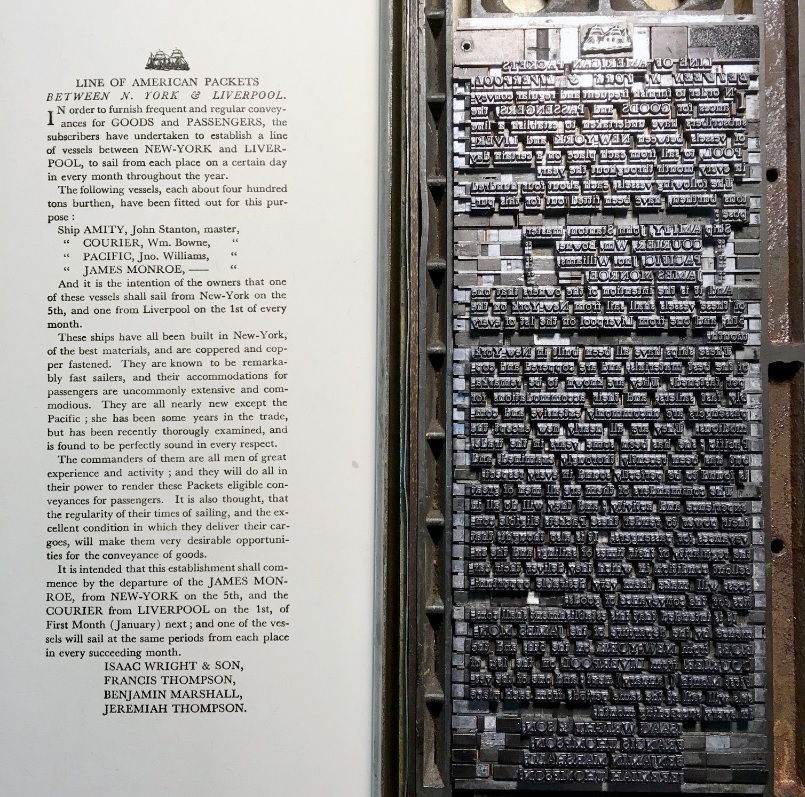
The Black Ball Line founders printed an announcement in The New-York Evening Post on October 27, 1817 describing how they were going to “establish a line of vessels between New York and Liverpool, to sail from each place on a certain day in every month throughout the year.” The first four vessels from their Line were “about four hundred tons burthen, have been fitted out for this purpose:
Ship Amity, John Stanton, master,
Ship Courier, Wm. Bowne, master,
Ship Pacific, Jno. Williams, master,
Ship James Monroe, ——”
The advertisement boasted that the commanders of all these ships were “men of great experience and activity” and speculated that “the regularity of their times of sailing […] will make them very desirable opportunities for the conveyance of goods.”
The image to the left is a recreation of the advertisement, made by Bowne & Co., using 19th century techniques.
The image to the right is the form, which was hand set, letter by letter and line by line, using metal movable type.
This, of course, turned out to be quite true. Thanks in part to the Black Ball Line’s innovation, the Port of New York became a “top-notch” port, outshining Boston and Philadelphia.
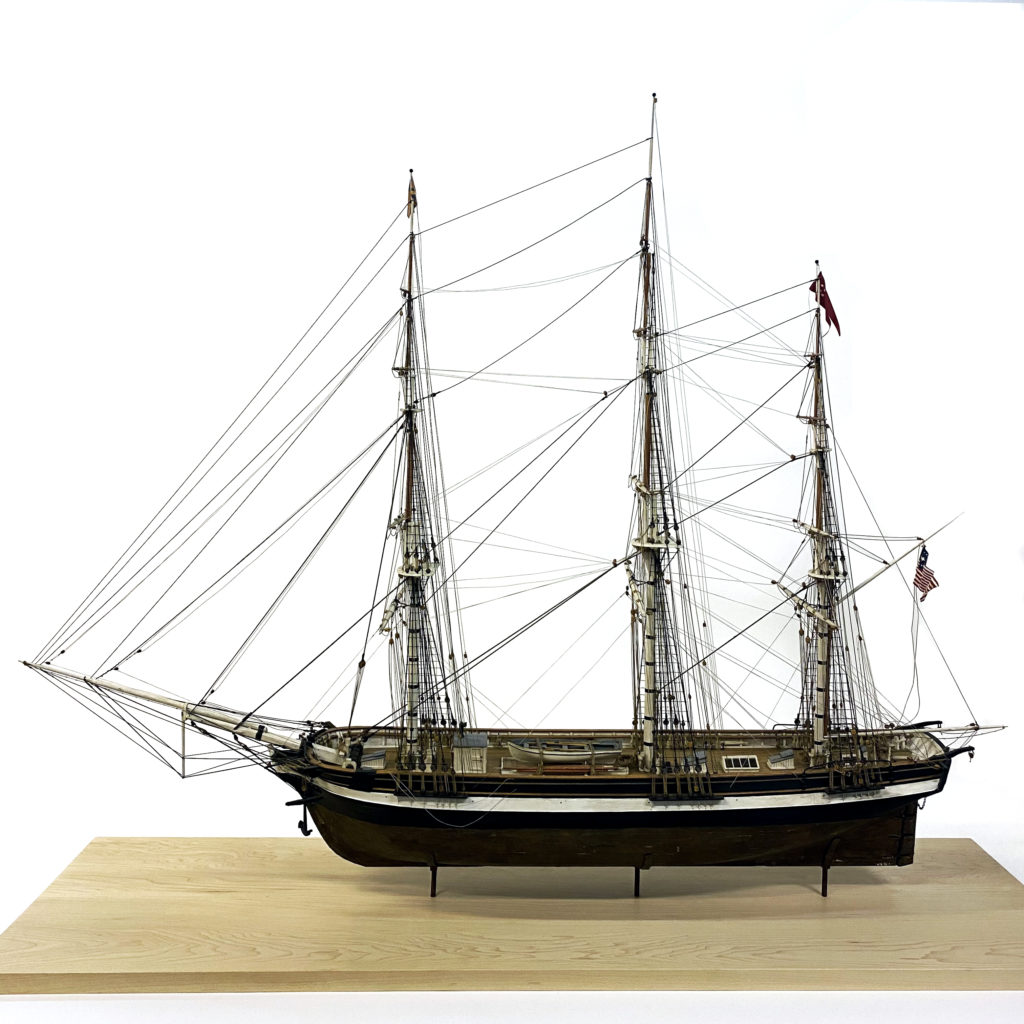
The Black Ball Line of three ships was established in April 1817, with the ships originally intended to sail in succession, though not, like the later packets, on a fixed schedule.
The addition of the James Monroe as a fourth ship, on October 24, 1817, named for the newly elected president, led to the announcement of the first regular transatlantic ship service: “To sail on their Appointed Days, full or not full.” The fifth of the month was fixed as the departure date from New York, while ships were to sail from Liverpool on the seventeenth, beginning in January 1818.
William E. Hitchcock (1928-2006), maker. “Scale model of the Black Ball liner James Monroe” ca. 1969. Museum Purchase 1974.073.0001
The four founders of what became known as the Black Ball Line were Isaac Wright & Son, Francis Thompson, Benjamin Marshall, and Jeremiah Thompson.
While cross referencing the Line founders historical records and life, and the Bowne family ones to catch a few more possible connections, one important aspect came to light.
Jeremiah Thompson was an officer in the New York Manumission Society, a group dedicated to freeing slaves of which Robert Bowne Minturn was also part of of. Where do they know each other? But Thompson also made a fortune by exporting raw cotton, grown in the American South by slave labor. How did he reconcile with it? Unfortunately it is something we will most likely never know.
Thompson was an English immigrant from Yorkshire who had come to New York at age seventeen in 1801 to join his uncle in representing the family’s woolen manufacturing business. From that base they engaged in shipping and ship owning. Thompson, dealing in volatile markets for finished imports and raw exports, wanted faster, more reliable service. He conceived the notion of a transatlantic ship line as “several vessels under coordinated private management, sailing on known dates between established ports, and locked into an unchanging departure schedule for the foreseeable future.”[2] “‘Transatlantic’ First Chapter” by Stephen Fox, published in The New York Times, on September 14, 2003.
Outcomes
Even as the Black Ball Line was the first and most famous American packet ship line to carry passengers and cargo from New York to Liverpool and back, the steamship’s arrival in the late 1800s opened the way for the downfall of the sailing ship business. Steamships were faster than the sailing packets, virtually cutting the voyage time in half. Three of the five largest packet lines all closed down before 1878, and by the summer of that year, even the famous Black Ball Line was forced to close down.
There is so much more to untangle from these materials; this blog is just to give you quick insight to the life of collections managers, collection specialists, registrars, and interns who process donations at the Seaport Museum. On a daily basis we are faced with the preservation, catalog, inventory, research, and interpretation of newly acquired artifacts as well as the ones that are in our possession from a while.
New donations could be indeed full of surprises, and often it takes years, and dedicated staff efforts, to reveal historical connections, and details; but this process is also an ongoing task of our department. While we inventory, rehouse, and digitize items, we do “spot-check” research and often find more information to add on the artifacts’ records on our collection management database.
Now you might be asking, what will be next for these items?
Well, for the logs, we’ll need some time to read it through, transcribe some important aspects, and eventually process their digitization. They are already nicely housed in acid free boxes, and they’ll be waiting for their new next steps.
The document and drawing have been digitized and re-homed as well. Most of their research has been already saved, and we might just have to add on some additional information on President James Monroe official documents and seal. We’re excited to find what will be next for them!
Additional Readings and Resources
“Memoir of Robert Bowne Minturn” by Robert Bowne Minturn, printed for private circulation in 1871.
“Edmund A. Stanley, Jr. Collection relating to Bowne & Co.” Manuscripts and Archives Division, The New York Public Library.
“Mayor Walter Bowne and his very exceptional family story” by Greg Young. The Bowery Boys, November 11, 2021; accessed on February 20, 2022.
“Of Men and Dreams” The Robert Bowne Foundation; accessed on February 20, 2022.
Acquisition Guidelines
The Seaport Museum’s Collection Management Policy, last revised in May of 2024, outlines the scope of the Museum’s collection, explains how the museum grows, cares for and makes collections available to the public, and clearly defines the roles of the parties responsible for managing these artifacts.
References
| ↑1 | “NEIGHBORHOOD REPORT: FLUSHING; For a Beacon of Freedom, A Troubling New Light” by Jim O’Grady, published in The New York Times on February 24, 2004. |
|---|---|
| ↑2 | “‘Transatlantic’ First Chapter” by Stephen Fox, published in The New York Times, on September 14, 2003. |

